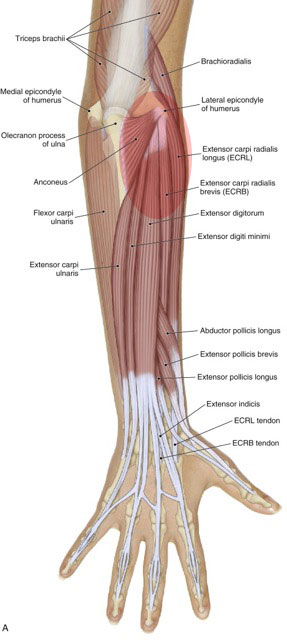Signs and symptoms of tennis elbow:

Tennis elbow involves pain at the common extensor belly/tendon and the lateral epicondyle of the humerus. Permission: Joseph E. Muscolino, The Muscle and Bone Palpation Manual, with Trigger Points, Referral Patterns, and Stretching, 2ed. (2016), Elsevier.
The most common symptoms of tennis elbow (lateral epicondylitis, lateral epicondylosis) are pain and tightness at the common extensor belly/tendon, directly distal to the lateral epicondyle of the humerus. This tightness might be global tightness of the entire belly or bellies of the associated muscles, or might manifest as myofascial trigger points (TrPs). The pain will usually occur with contraction of the muscles of the common extensor tendon, whether it is concentric, eccentric, or isometric stabilization contraction. Pain as well as tightness will also be evident with palpation of the proximal bellies of the associated musculature and their proximal common extensor tendon. Pain might also occur when the muscles of the common extensor tendon are stretched; this would occur when the hands and/or fingers are actively or passively moved into flexion. If the tightness of the musculature of the common extensor tendon is sufficient, it might also cause decreased active or passive flexion range of motion of the wrist joint. Due to its role in stabilization of the wrist joint, the most commonly affected muscle with tennis elbow is the extensor carpi radialis brevis.
With continuing overuse, the constant pulling of the common extensor tendon upon its bony attachment will eventually lead to irritation, swelling, and therefore pain at the periosteum of the lateral epicondyle of the humerus. Therefore, even though this condition is technically named for the lateral epicondylar attachment, pain at the lateral epicondyle itself does not usually occur until this condition has progressed to be more chronic and severe.
In the early stages of this condition, in addition to pain, swelling is also usually present at the common extensor belly/tendon and can usually be felt on palpatory examination. The swelling can also spread to the lateral epicondyle and may also be visualized; look for the bony contours of the lateral elbow to be less evident compared to the other side of the patient’s/client’s body. In later stages of this condition, usually after a period of six months or more, the swelling gradually recedes and degeneration of the collagen construct of the common tendon occurs. As this transition in pathophysiology occurs, the description of this condition changes from lateral epicondylitis to lateral epicondylosis (as previously mentioned). Due to the degeneration of the tendon and the continued pull of muscular contraction, tearing of the tendon may also occur.
If tennis elbow is left unresolved for a very long time, because its underlying cause is overuse and irritation of the extensor musculature of the posterior forearm, tendinitis of the distal tendons of these muscles at the wrist joint is a possible consequence.
Click here for an article on the signs and symptoms of golfer’s elbow.
Note: This is the second of five blog post articles on tennis elbow.
The five articles are:
- What are the causes of Tennis Elbow?
- What are the signs and symptoms of Tennis Elbow?
- How do we assess (diagnose) Tennis Elbow?
- How do we treat Tennis Elbow with manual therapy?
- What are the self-care and medical approaches to Tennis Elbow?


